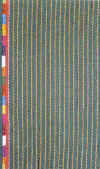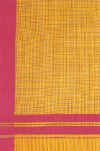|
|
|
||||
|
APRIL 2002 Contents
Travel 'Baikunth'
- the mountain Literature Visual Arts Jatin
Das - 4 decades of Music Zakir
Hussain - Compelling Hakim
Ajmal Khan's ancestral Business & Economy Performing Arts 'Fakir
of Benares' -1922 French Films Revathy
Menon's 'Mitr - my Books 'Knock
at Every Alien Door' People
Books
|
|
|
|||
| print gallery | |||||
|
Page 4 of 4
Textiles of Pakistan - Past & Present (cntd) by Shehnaz Ismail.
Mohammed Farooq Textile Mill was established in 1967 in Karachi to produce yarn and gray cloth, all for export to Japan, Europe and United States of America. Yarn was exported to the far East. In 1973, Mohammed Farooq became the first textile mill to produce polycottons and poly viscose for the local market. From 1973-1985, it catered to the domestic market only, because of heavy import duties on fiber. In 1985, synthetic and blended fabrics were exported. Today out of the total exports of fabric, seventy per cent is cotton and thirty percent is synthetic. There is a every large presence of spinning mills [about 450] as compared to about thirty composite textile mills. It was in the 60s that the power loom took over and by the 70s gray cloth was being exported at throwaway prices. There are about 200,000 power looms operating in Pakistan some of which are backyard operations. Handloom, which formed the backbone of textile goods in the last century, is now almost non-existent, its sales confined to a fast diminishing rural market and a very small niche market. Although Pakistan is the world’s fourth largest cotton growing nation in the world, after the United States, China , and India, its total turnover for export is only $ 5 billion. Textile goods form 60 % of the total exports of the country. The commodities exported are yarn, cloth, tents, and canvas, bags, towels, bed linen, garments, synthetic textiles and other made ups. With a large and expanding textile industry, textile education and training became imperative. The Textile University of Pakistan was established in Karachi to train technical and management professionals. The Textile University awards degrees in Textile Sciences and Textile Management. The National College of Arts in Lahore and the Indus Valley School of Art and Architecture in Karachi are the only two institutions in Pakistan, which award a degree in the discipline of Textile Design. Designers are being absorbed into the industry, bringing about change and vibrancy, with innovations in Print design and weaving. The young designers namely Rizwan Beyg, Nilofer Shahid, Wasim and Faiza Samee are well known in Pakistan and have earned recognition in the global market as well. They have made inroads in the haute couture world and their creations are part of museums collections in Europe and North America. Rizwan Beyg was responsible for making Pakistan’s national dress the shalwar kurta chic and fashionable in the western world. The late Princes Diana chose to wear his design in Pakistan and later in London. The overall environment determines the progress and growth of industry. From one mill in 1947 the textile industry in Pakistan has come a long way, overcome many obstacles, changing governments and economic nightmares. With a dynamic heritage that begins with the Indus valley civilization, Pakistan hopes to step into the 21st century with the mission of establishing its identity in the global market. PAKISTAN’S TEXTILE EXPORTS AND MAJOR MARKETS 1996-97 Cotton Yarn - HongKong, Japan, S.Korea, European Common Market, Dubai. Cotton Cloth - ECM, HongKong, U.S.A., Bangla Desh, Australia, Garments - U.S.A., Germany, U.K., France. Netherlands. Made-ups - U.S.A., U.K., Germany, Italy, France. Bed Linen - Germany, U.S.A., U.K., Netherlands, France. Towels - U.S.A., Germany, U.K., Saudi Arabia, Canada. Tents & Canvas - Saudi Arabia, Kuwait, Dubai, Sri Lanka, Qatar. Knitwear - U.S.A, Germany, U.K., France, Netherlands, Synthetics, U.K., Belgium, Dubai, Hosiery Saudi Arabia, Italy.
EXPORT EARNINGS 1996-97 [ MILLIONS US $ ] COTTON YARN 1,397 COTTON CLOTH 1,217 READY MADE GARMENTS 727 KNITWEAR /HOSIERY 671 SYNTHETIC TEXTILES 496 BED LINEN 442 MADE-UPS 207 TENTS & CANVAS 34 COTTON 30 OTHER TEXTILE PRODUCTS 57 TOTAL 5,473
TEXTILE SECTOR ‘S SHARE IN PAKISTAN ECONOMY: SHARE IN GDP 8.5 % SHARE IN EXPORTS 67 % SHARE IN EMPLOYMENT 40 %
________________________________
|
|||||
| Copyright © 2000 [the-south-asian.com]. Intellectual Property. All rights reserved. | |||||
| Home | |||||



